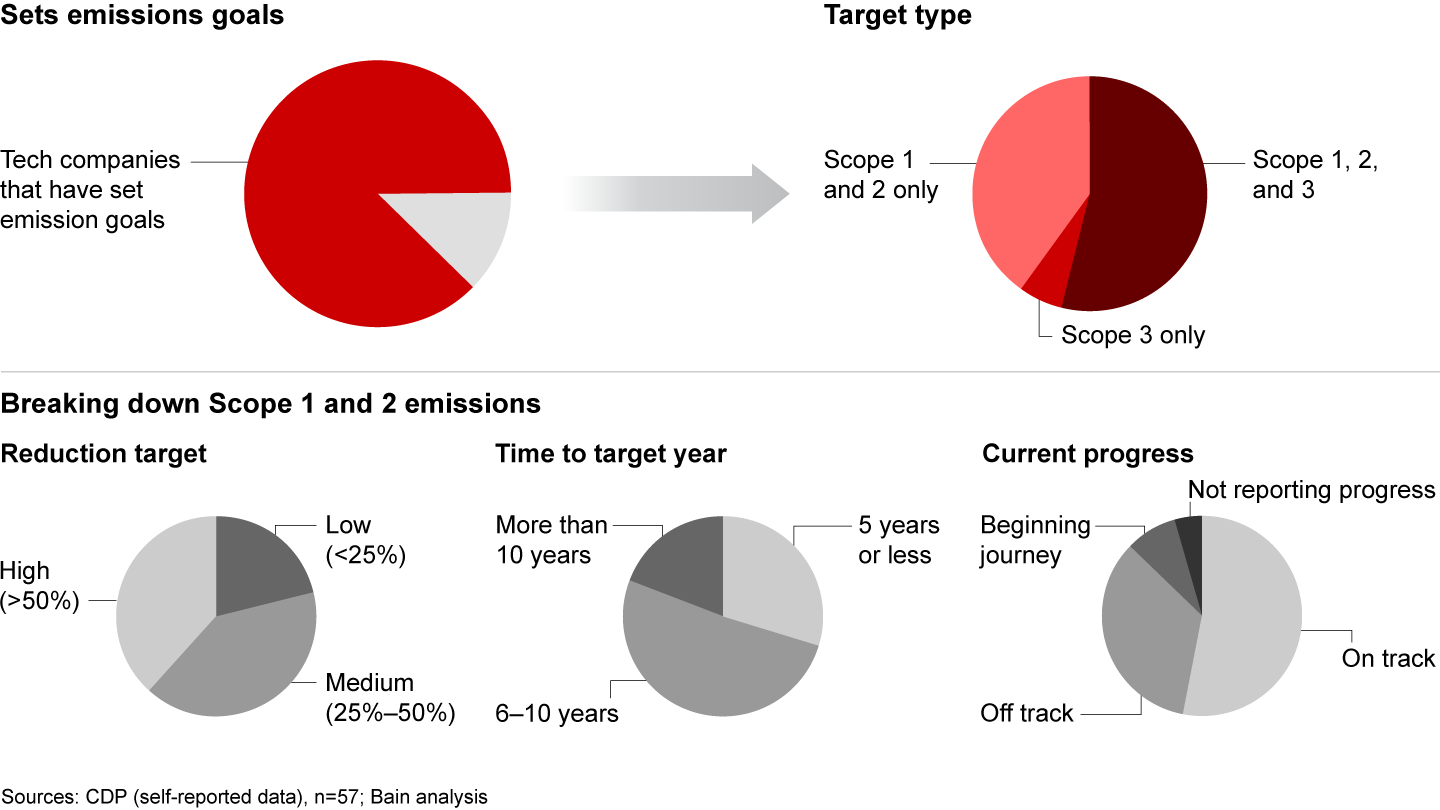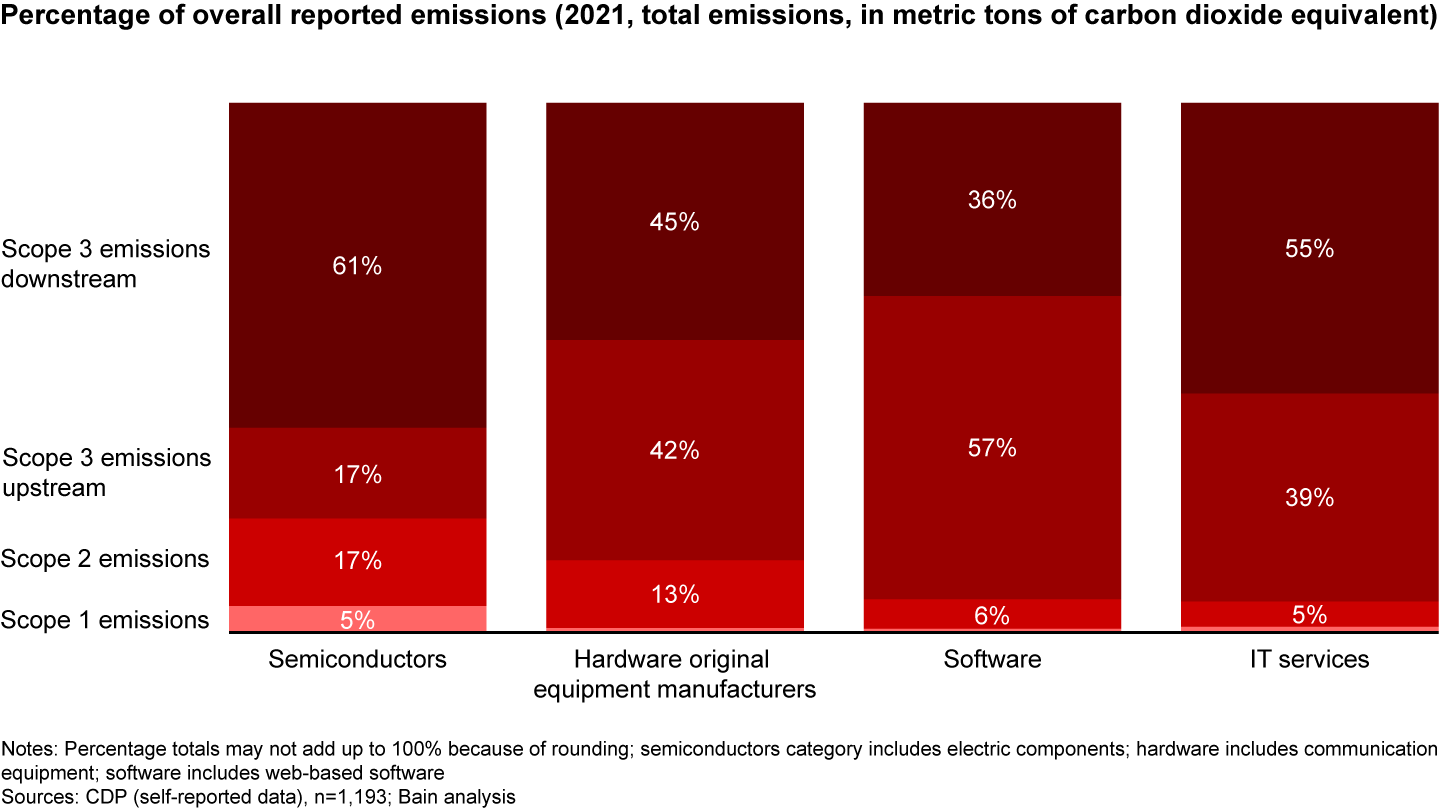Technology Report

Executive Summary
- In technology, most emissions are Scope 3, resulting from upstream supply chains or downstream use of products, which are harder for companies to control than Scope 1 (operations) or Scope 2 (energy use) emissions that are under their direct control.
- Using more renewable energy in data centers helps many software companies reduce their Scope 2 emissions.
- Bringing supply lines closer to customers can reduce upstream Scope 3 emissions, while redesigning products to use less energy helps reduce downstream Scope 3 emissions.
- Companies should adopt a holistic perspective so that they can take a long-term strategic approach to emissions and other sustainability issues.
This article is part of Bain's 2023 Technology Report.
Sustainability and decarbonization efforts increasingly are top priorities for technology companies as customers, shareholders, and regulators all push for more sustainable products and services. In response, most tech companies are setting ambitious goals to reduce emissions, but only half report being on track to reach their goals (see Figure 1). Most emission reduction goals focus on Scope 1 (direct emissions from a company’s activity) and Scope 2 (emissions from purchased electricity, heat, and steam), which companies have more control over. Scope 3 emissions come from the upstream supply chain and flow downstream to customer use.


Why is reducing emissions so hard? First, most emissions are Scope 3, which are more difficult to control. Also, reductions compete with other strategic priorities. For example, PC makers need to find sustainable solutions to extend the life of their products without jeopardizing long-term sales.
The ambitions may be clear, but the devil is in the execution. Improvement initiatives require complex coordination across manufacturing, operations, engineering, and R&D teams, as well as customers. Regulations differ across locations. Even with offset purchases as part of the strategy, companies might find it hard to source enough renewable power in some markets. Launching, tracking, and following through on implementation requires senior sponsorship and commitment—and a willingness to tackle cross-organizational and cross-regional challenges.
Successful measures
The causes of carbon emissions vary by subsector (see Figure 2). Emissions in semiconductors derive mostly from Scope 3 downstream usage, but the sector also has the largest Scope 1 and Scope 2 emissions. Hardware manufacturers’ emissions result from Scope 3 downstream electricity usage and the upstream supply chain for materials and minerals. The software industry’s emissions come from customers using their products (Scope 3 downstream) as well as the goods and services that software companies buy to make their products (Scope 3 upstream).


While specific solutions may look different for hardware and software companies, all tech companies are embedding the impact of carbon into decision making around supply chain footprint, day-to-day operations, and product life cycles. Across subsectors, tech companies are finding ways to reduce carbon emissions.
- Data centers: Many companies are using more renewable energy in their daily operations. For example, Microsoft committed to using 100% renewable energy by 2025 for electricity in its data centers and buildings, and it says it reduced Scope 2 emissions by 30% to 35% from 2021 to 2022. Some are reducing emissions by developing new, more energy-efficient ways to cool servers. Intel recently formed a partnership with specialty chemical maker Lubrizol to design and create immersion-cooling fluid solutions that don’t void the warranty on Intel microarchitectures. Immersion-cooling technology could reduce the energy required to cool servers in data centers by more than 30% vs. traditional air-cooling solutions.
- Optimizing the supply chain: As companies evaluate bringing suppliers closer to end markets, many are looking not only at economic costs but also at their carbon footprint to help decide who to source from and where to locate new manufacturing sites. Bringing suppliers closer to customers can reduce emissions in transportation and energy consumption when the destination uses cleaner or renewable energy sources. For example, one major tech company is shifting some of its production from Asia to North America not only to help guard against future supply chain disruptions but also to increase sustainability and responsiveness by locating closer to more customers, which reduces transportation-related emissions and delivery time.
- Redesigning products: Companies are redesigning their products so that they consume less energy or cleaner energy in order to reduce downstream Scope 3 emissions. For example, Apple’s Clean Energy Charging setting, which limits charging to periods when lower carbon-emission electricity is available, helps Apple reduce downstream Scope 3 emissions in the US.
- New business models that balance financial and emissions trade-offs: New business models are proving to be a win-win for decarbonization efforts and for technology companies’ financials. For example, companies that adopt hardware-as-a-service models could extend the life of products or make them modular to lengthen times between replacement. This could allow them to generate revenue for longer on each asset while also reducing their carbon footprint by manufacturing less hardware.
“No regret” actions
A phased approach helps companies bridge the gap between sustainability goals and results.
The first step is gaining a better understanding by mapping the major sources of carbon emissions in the supply chain. This can reveal opportunities for reductions. For example, choosing a renewable energy source for the company’s and suppliers’ energy needs is often low-hanging fruit, achievable during the early stages of decarbonization.
Next, companies should adopt a long-term, holistic perspective and develop new business models that strengthen competitive advantages. By strategically addressing emission sources, embracing innovative business models, and making thoughtful strategic choices, companies can succeed financially while becoming more sustainable. Although most customers are still not willing to pay much of a green premium for sustainable products, they are becoming more conscious of their environmental impact and are actively seeking out eco-friendly options.
Finally, tech companies face increasing pressure from regulators to disclose and reduce Scope 1, 2, and 3 emissions as part of their financial reporting. The EU’s Corporate Sustainability Reporting Directive and the US Security and Exchange Commission’s new reporting rules are among the measures that will help ensure that companies develop sound climate strategies for reducing emissions and that they comply with disclosure requirements.